Grumman F6F Hellcat
The Grumman F6F Hellcat is an American carrier-based fighter aircraft of World War II. Designed to replace the earlier F4F Wildcat and to counter the Japanese Mitsubishi A6M Zero, it was the United States Navy's dominant fighter in the second half of the Pacific War, outdueling the faster Vought F4U Corsair, which had problems with carrier landings.
| F6F Hellcat | |
|---|---|
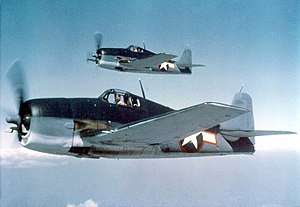 | |
| Grumman F6F-3 Hellcats in tricolor camouflage[1][Note 1] | |
| Role | Carrier-based fighter aircraft |
| National origin | United States |
| Manufacturer | Grumman |
| First flight | 26 June 1942 |
| Introduction | 1943 |
| Retired | 1960 Uruguayan Navy[2] |
| Primary users | United States Navy |
| Produced | 1942–45 |
| Number built | 12,275 |
| Unit cost |
$35,000 in 1945[3] |
Powered by a 2,000 hp (1,500 kW) Pratt & Whitney R-2800 Double Wasp, the same powerplant used for both the Corsair and the United States Army Air Forces (USAAF) Republic P-47 Thunderbolt fighters, the F6F was an entirely new design, but it still resembled the Wildcat in many ways.[4] Some military observers tagged the Hellcat as the "Wildcat's big brother".[5]
The F6F made its combat debut in September 1943, and was best known for its role as a rugged, well-designed carrier fighter, which was able to outperform the A6M Zero and help secure air superiority over the Pacific theater. A total of 12,275 were built in just over two years.[6]
Hellcats were credited with destroying a total of 5,223 enemy aircraft while in service with the U.S. Navy, U.S. Marine Corps, and Royal Navy Fleet Air Arm.[7][Note 2] This was more than any other Allied naval aircraft.[9] Postwar, the Hellcat was phased out of front-line service, but remained in service as late as 1954 as a night fighter.
Design and development
XF6F
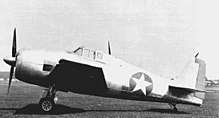
.jpg)
Grumman had been working on a successor to the F4F Wildcat since 1938 and the contract for the prototype XF6F-1 was signed on 30 June 1941. The aircraft was originally designed to use the Wright R-2600 Twin Cyclone two-row, 14-cylinder radial engine of 1,700 hp (1,300 kW) (the same engine used with Grumman's then-new torpedo bomber under development), driving a three-bladed Curtiss Electric propeller.[10] Instead of the Wildcat's narrow-track, hand-cranked main landing gear retracting into the fuselage that it had inherited, little changed in design from the 1931-debuted Grumman FF-1 fighter biplane, the Hellcat had wide-set, hydraulically actuated landing gear struts that rotated through 90° while retracting backwards into the wings, but with full wheel doors fitted to the struts that covered the entire strut and the upper half of the main wheel when retracted, and twisted with the main gear struts through 90º during retraction.[11] The wing was mounted lower on the fuselage and was able to be hydraulically or manually folded, with each panel outboard of the undercarriage bay folding backwards from pivoting on a specially oriented, Grumman-patented "Sto-Wing" diagonal axis pivoting system much like the earlier F4F, with a folded stowage position parallel to the fuselage with the leading edges pointing diagonally down.[12]
Throughout early 1942, Leroy Grumman, along with his chief designers Jake Swirbul and Bill Schwendler, worked closely with the U.S. Navy's Bureau of Aeronautics (BuAer) and experienced F4F pilots,[13] to develop the new fighter in such a way that it could counter the Zero's strengths and help gain air command in the Pacific Theater of Operations.[14] On 22 April 1942, Lieutenant Commander Butch O'Hare toured the Grumman Aircraft company and spoke with Grumman engineers, analyzing the performance of the F4F Wildcat against the Mitsubishi A6M Zero in aerial combat.[15][Note 3] BuAer's Lt Cdr A. M. Jackson [Note 4] directed Grumman's designers to mount the cockpit higher in the fuselage.[18] In addition, the forward fuselage sloped down slightly to the engine cowling, affording the Hellcat's pilot good visibility.[19]
Change of powerplant
Based on combat accounts of encounters between the F4F Wildcat and A6M Zero, on 26 April 1942, BuAer directed Grumman to install the more-powerful, 18-cylinder Pratt & Whitney R-2800 Double Wasp radial engine – already powering Chance Vought's Corsair design since its own beginnings in 1940 – in the second XF6F-1 prototype.[20] Grumman complied by redesigning and strengthening the F6F airframe to incorporate the 2,000 hp (1,500 kW) R-2800-10, driving a three-bladed Hamilton Standard propeller. With this combination, Grumman estimated the XF6F-3s performance would increase by 25% over that of the XF6F-1.[5] The Cyclone-powered XF6F-1 (02981) first flew on 26 June 1942, followed by the first Double Wasp-equipped aircraft, the XF6F-3 (02982), which first flew on 30 July 1942. The first production F6F-3, powered by an R-2800-10, flew on 3 October 1942, with the type reaching operational readiness with VF-9 on USS Essex in February 1943.[21] [Note 5]
Further development
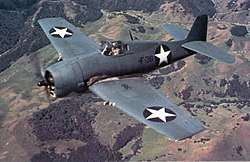
The F6F series was designed to take damage and get the pilot safely back to base. A bullet-resistant windshield and a total of 212 lb (96 kg) of cockpit armor was fitted, along with armor around the oil tank and oil cooler. A 250 US gal (950 l) self-sealing fuel tank was fitted in the fuselage.[21] Standard armament on the F6F-3 consisted of six .50 in (12.7 mm) M2/AN Browning air-cooled machine guns with 400 rounds per gun. A center-section hardpoint under the fuselage could carry a single 150 US gal (570 l) disposable drop tank, while later aircraft had single bomb racks installed under each wing, inboard of the undercarriage bays; with these and the center-section hard point late model F6F-3s could carry a total bomb load in excess of 2,000 lb (910 kg). Six 5 in (127 mm) high-velocity aircraft rockets (HVARs) could be carried – three under each wing on "zero-length" launchers.[22][23]
Two night fighter subvariants of the F6F-3 were developed; the 18 F6F-3E's were converted from standard-3s and featured the AN/APS-4 10 GHz frequency radar in a pod mounted on a rack beneath the right wing, with a small radar scope fitted in the middle of the main instrument panel and radar operating controls installed on the port side of the cockpit.[24] The later F6F-3N, first flown in July 1943, was fitted with the AN/APS-6 radar in the fuselage, with the antenna dish in a bulbous fairing mounted on the leading-edge of the outer right wing as a development of the AN/APS-4; about 200 F6F-3Ns were built.[25] Hellcat night fighters claimed their first victories in November 1943.[26] A total of 4,402 F6F-3s was built through until April 1944, when production was changed to the F6F-5.[19]

The F6F-5 featured several improvements, including a more powerful R-2800-10W engine employing a water-injection system and housed in a slightly more streamlined engine cowling, spring-loaded control tabs on the ailerons, and an improved, clear-view windscreen, with a flat armored-glass front panel replacing the F6F-3's curved plexiglass panel and internal armor glass screen.[11][19] In addition, the rear fuselage and tail units were strengthened, and apart from some early production aircraft, the majority of the F6F-5's built were painted in an overall gloss sea-blue finish.[27] After the first few F6F-5s were built, the small windows behind the main canopy were deleted.[28] The F6F-5N night-fighter variant was fitted with an AN/APS-6 radar in a fairing on the outer-starboard wing. A few standard F6F-5s were also fitted with camera equipment for reconnaissance duties as the F6F-5P.[29] While all F6F-5s were capable of carrying an armament mix of one 20-mm (.79-in) M2 cannon in each of the inboard gun bays (220 rounds per gun), along with two pairs of .50-in (12.7-mm) machine guns (each with 400 rounds per gun), this configuration was only used on later F6F-5N night fighters.[30] The F6F-5 was the most common F6F variant, with 7,870 being built.[19]
Other prototypes in the F6F series included the XF6F-4 (02981, a conversion of the XF6F-1 powered by an R-2800-27 and armed with four 20-mm M2 cannon) which first flew on 3 October 1942 as the prototype for the projected F6F-4. This version never entered production and 02981 was converted to an F6F-3 production aircraft.[31] Another experimental prototype was the XF6F-2 (66244), an F6F-3 converted to use a Wright R-2600-15, fitted with a Birman-manufactured mixed-flow turbocharger, which was later replaced by a Pratt & Whitney R-2800-21, also fitted with a Birman turbocharger.[32] The turbochargers proved to be unreliable on both engines, while performance improvements were marginal. As with the XF6F-4, 66244 was soon converted back to a standard F6F-3.[33] Two XF6F-6s (70188 and 70913) were converted from F6F-5s and used the 18-cylinder 2,100 hp (1,566 kW) Pratt and Whitney R-2800-18W two-stage supercharged radial engine with water injection and driving a Hamilton-Standard four-bladed propeller.[34] The XF6F-6s were the fastest version of the Hellcat series with a top speed of 417 mph (671 km/h), but the war ended before this variant could be mass-produced.[11][35]
The last Hellcat rolled out in November 1945, the total production being 12,275, of which 11,000 had been built in just two years.[36] This high production rate was credited to the sound original design, which required little modification once production was under way.
Operational history
U.S. Navy and Marines
The U.S. Navy much preferred the more docile flight qualities of the F6F compared with the Vought F4U Corsair, despite the superior speed of the Corsair. This preference was especially noted during carrier landings, a critical success requirement for the Navy, in which the Corsair was fundamentally flawed in comparison. The Corsair was thus released by the Navy to the Marine Corps, which without the need to worry about carrier landings, used the Corsair to immense effect in land-based sorties. The Hellcat remained the standard USN carrier-borne fighter until the F4U series was finally cleared for U.S. carrier operations in late 1944 (the carrier landing issues had by now been tackled largely due to use of Corsair by the Royal Navy Fleet Air Arm).[37] In addition to its good flight qualities, the Hellcat was easy to maintain and had an airframe tough enough to withstand the rigors of routine carrier operations.[38] Like the Wildcat, the Hellcat was designed for ease of manufacture and ability to withstand significant damage.
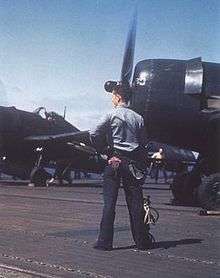
The Hellcat first saw action against the Japanese on 1 September 1943, when fighters off USS Independence shot down a Kawanishi H8K "Emily" flying boat.[39] Soon after, on 23 and 24 November, Hellcats engaged Japanese aircraft over Tarawa, shooting down a claimed 30 Mitsubishi Zeros for the loss of one F6F.[39] Over Rabaul, New Britain, on 11 November 1943, Hellcats and F4U Corsairs were engaged in day-long fights with many Japanese aircraft including A6M Zeros, claiming nearly 50 aircraft.[39]
When trials were flown against a captured A6M5 model Zero, they showed that the Hellcat was faster at all altitudes. The F6F out-climbed the Zero marginally above 14,000 ft (4,300 m) and rolled faster at speeds above 235 mph (378 km/h). The Japanese fighter could out-turn its American opponent with ease at low speed and enjoyed a slightly better rate of climb below 14,000 ft (4,300 m). The trials report concluded:
Do not dogfight with a Zero 52. Do not try to follow a loop or half-roll with a pull-through. When attacking, use your superior power and high speed performance to engage at the most favorable moment. To evade a Zero 52 on your tail, roll and dive away into a high speed turn.[40]
Hellcats were the major U.S. Navy fighter type involved in the Battle of the Philippine Sea, where so many Japanese aircraft were shot down that Navy aircrews nicknamed the battle the "Great Marianas Turkey Shoot". The F6F accounted for 75% of all aerial victories recorded by the U.S. Navy in the Pacific.[41] Radar-equipped Hellcat night fighter squadrons appeared in early 1944.
A formidable opponent for the Hellcat was the Kawanishi N1K, but it was produced too late and in insufficient numbers to affect the outcome of the war.[42]
Sortie, kill, and loss figures
U.S. Navy and Marine F6F pilots flew 66,530 combat sorties and claimed 5,163 kills (56% of all U.S. Navy/Marine air victories of the war) at a recorded cost of 270 Hellcats in aerial combat (an overall kill-to-loss ratio of 19:1 based on claimed kills).[43] Claimed victories were often highly exaggerated during the war. Even so, the aircraft performed well against the best Japanese opponents with a claimed 13:1 kill ratio against the A6M Zero, 9.5:1 against the Nakajima Ki-84, and 3.7:1 against the Mitsubishi J2M during the last year of the war.[44] The F6F became the prime ace-maker aircraft in the American inventory, with 305 Hellcat aces. The U.S. successes were not just attributed to superior aircraft – from 1942 onwards, they faced increasingly inexperienced Japanese aviators and had the advantage of increasing numerical superiority.[Note 6] In the ground-attack role, Hellcats dropped 6,503 tons (5,899 tonnes) of bombs.[43]
The U.S. Navy's all-time leading ace, Captain David McCampbell, scored all his 34 victories in the Hellcat. He once described the F6F as "... an outstanding fighter plane. It performed well, was easy to fly, and was a stable gun platform, but what I really remember most was that it was rugged and easy to maintain."[46]
During the course of World War II, 2,462 F6F Hellcats were lost to all causes – 270 in aerial combat, 553 to antiaircraft ground and shipboard fire, and 341 due to operational causes. Of the total figure, 1,298 were destroyed in training and ferry operations, normally outside of the combat zones.[47]
Hamilton McWhorter III was a United States Navy aviator and a flying ace of World War II, credited with shooting down twelve Japanese aircraft. He was the first United States Navy aviator to become an ace while flying the Grumman F6F Hellcat and the first Navy carrier pilot to achieve double ace status.[48]
British use
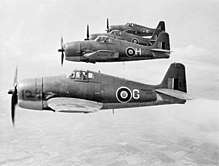
The British Fleet Air Arm (FAA) received 1,263 F6Fs under the Lend-Lease Act; initially it was known as the Grumman Gannet Mark I. The name Hellcat replaced it in early 1943 for the sake of simplicity, the Royal Navy at that time adopting the use of the existing American naval names for all the U.S.-made aircraft supplied to it, with the F6F-3 being designated Hellcat F Mk.I, the F6F-5, the Hellcat F Mk.II and the F6F-5N, the Hellcat NF Mk.II.[Note 7] They saw action off Norway, in the Mediterranean, and in the Far East. Several were fitted with photographic reconnaissance equipment similar to the F6F-5P, receiving the designation Hellcat FR Mk.II.[49] The Pacific War being primarily a naval war, the FAA Hellcats primarily faced land-based aircraft in the European and Mediterranean theaters,[50][51] and as a consequence experienced far fewer opportunities for air-to-air combat than their USN/Marines counterparts, nevertheless, they claimed a total of 52 enemy aircraft kills during 18 aerial combats from May 1944 to July 1945. 1844 Naval Air Squadron, on board HMS Indomitable of the British Pacific Fleet was the highest scoring unit, with 32.5 kills.[52]
FAA Hellcats, as with other Lend-Lease aircraft, were rapidly replaced by British aircraft after the end of the war, with only two of the 12 squadrons equipped with the Hellcat at VJ-Day still retaining Hellcats by the end of 1945. These two squadrons were disbanded in 1946.
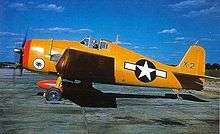
Postwar use
After the war, the Hellcat was succeeded by the F8F Bearcat, which was smaller, more powerful (powered by uprated Double Wasp radials) and more maneuverable, but entered service too late to see combat in World War II.[54]
The Hellcat was used for second-line USN duties, including training, Naval Reserve squadrons, and a handful were converted to target drones.[55] In late 1952, Guided Missile Unit 90 used F6F-5K drones, each carrying a 2,000 lb (910 kg) bomb, to attack bridges in Korea; flying from USS Boxer, radio controlled from an escorting AD Skyraider.[56]
The French Aéronavale was equipped with F6F-5 Hellcats and used them in Indochina. These were painted in Gloss Sea Blue, similar to post-World War II US Navy aircraft until about 1955, but had a modified French roundel with an image of an anchor.[57]
The Uruguayan Navy also used them until the early 1960s.[58]
The F6F-5 subtype also gained fame as the first aircraft used by the U.S. Navy's Blue Angels official flight demonstration team at its formation in 1946.[59]
Variants
XF6F prototypes
- XF6F-1
- First prototype, powered by a two-stage 1,600 hp (1,193 kW) Wright R-2600-10 Cyclone 14 radial piston engine.
- XF6F-2
- The first XF6F-1 prototype revised and fitted with a turbocharged Wright R-2600-16 Cyclone radial piston engine. R-2600 replaced by turbocharged R-2800-21.
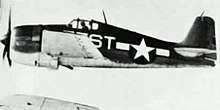
- XF6F-3
- Second prototype fitted with a two-stage supercharged 2,000 hp (1,491 kW) Pratt & Whitney R-2800-10 Double Wasp radial piston engine.
- XF6F-4
- One F6F-3 fitted with a two-speed turbocharged 2,100 hp (1,566 kW) Pratt & Whitney R-2800-27 Double Wasp radial piston engine.
- XF6F-6
- Two F6F-5s that were fitted with the 2,100 hp (1,566 kW) Pratt & Whitney R-2800-18W radial piston engine, and four-bladed propellers.
Series production
- F6F-3 (British designation Gannet F. Mk. I, and then later, renamed Hellcat F. Mk. I, January 1944)
- Single-seat fighter, fighter-bomber aircraft, powered by a 2,000 hp (1,491 kW) Pratt & Whitney R-2800-10 Double Wasp radial piston engine.
- F6F-3E
- Night fighter version, equipped with an AN/APS-4 radar in a fairing on the starboard outer wing.
- F6F-3N
- Another night fighter version, equipped with a newer AN/APS-6 radar in a fairing on the starboard outer wing.
- F6F-5 Hellcat (British Hellcat F. Mk. II)
- Improved version, with a redesigned engine cowling, a new windscreen structure with an integral bulletproof windscreen, new ailerons and strengthened tail surfaces; powered by a 2,200 hp (1,641 kW) Pratt & Whitney R-2800-10W (-W denotes Water Injection) radial piston engine.
- F6F-5K Hellcat
- A number of F6F-5s and F6F-5Ns were converted into radio-controlled target drones.
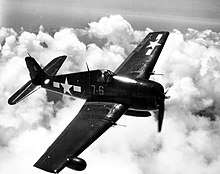
- F6F-5N Hellcat (British Hellcat N.F. Mk II)
- Night fighter version, fitted with an AN/APS-6 radar. Some were armed with two 20 mm (0.79 in) AN/M2 cannon in the inner wing bays and four 0.50 in (12.7 mm) M2 Browning machine guns in the outer.
- F6F-5P Hellcat
- Small numbers of F6F-5s were converted into photo-reconnaissance aircraft, with the camera equipment being fitted in the rear fuselage.
- Hellcat FR. Mk. II
- This designation was given to British Hellcats fitted with camera equipment.
- FV-1
- Proposed designation for Hellcats to be built by Canadian Vickers; cancelled before any built.[60]
Operators
- Uruguayan Navy
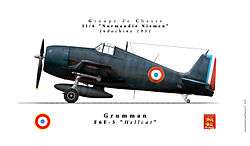 F6F-5 GC 2/6 Normandie-Niemen
F6F-5 GC 2/6 Normandie-Niemen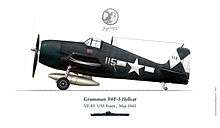 F6F-5 VF83
F6F-5 VF83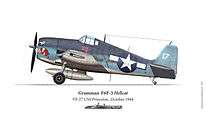 F6F-3 VF27
F6F-3 VF27 F6F-5 Flottille 1F
F6F-5 Flottille 1F
Surviving aircraft
A relatively large number of Grumman F6Fs survive to this day, either in museums or in flyable condition. In order of Bu.No. they are:[61]
United States
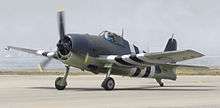
- Airworthy
- F6F-3
- 41476 – based at the Collings Foundation in Stow, Massachusetts.[63][64]
- 41930 – privately owned in Houston, Texas.[65]
- F6F-5
- 70222 – based at Commemorative Air Force (Southern California Wing) at Camarillo Airport (former Oxnard AFB) in Camarillo, California.[66][67]
- 79863 – based at Flying Heritage Collection in Everett, Washington.[68][69]
- 94204 – based at Erickson Aircraft Collection in Madras, Oregon.[70][71]
- 94473 – based at Palm Springs Air Museum in Palm Springs, California.[72][73]
- On display
- F6F-3
- 25910 – National Naval Aviation Museum at NAS Pensacola in Pensacola, Florida.[74]
- 41834 – Steven F. Udvar-Hazy Center of the National Air and Space Museum in Chantilly, Virginia.[75]
- 42874 – San Diego Aerospace Museum in San Diego, California.[76]
- 66237 – Naval Air Station Wildwood Aviation Museum at Cape May Airport in Lower Township, New Jersey.[77]
- F6F-5
.jpg)
- 77722 – Naval Air Facility Washington at Joint Base Andrews (former Andrews AFB) in Maryland.[78]
- 79192 – New England Air Museum in Windsor Locks, Connecticut.[79]
- 79593 – USS Yorktown/Patriots Point Naval & Maritime Museum in Mount Pleasant, South Carolina.[80]
- 79683 – Air Zoo in Kalamazoo, Michigan.[81]
- 94203 – National Naval Aviation Museum at NAS Pensacola in Pensacola, Florida.[82]
- 94263 – Cradle of Aviation Museum in New York. It is on loan from the USMC Museum in Quantico, Virginia.[83]
- Under restoration or in storage
- F6F-3
- 43041 – in storage at the Fantasy of Flight in Polk City, Florida.[84]
- F6F-5
- 70185 – in storage at the National Naval Aviation Museum at NAS Pensacola in Pensacola, Florida. It was on display at the Quonset Air Museum at Quonset State Airport (former NAS Quonset Point) in Quonset Point, Rhode Island. The Quonset Air Museum closed in December 2016.[85]
- 78645 – to airworthiness at Fagen Fighters WWII Museum in Granite Falls, Minnesota.[86][87]
- 80141 – to airworthiness Lewis Air Legends in San Antonio, Texas.[88][89]
- 93879 – to airworthiness by Yanks Air Museum in Chino, California.[90][91]
- 94385 – to airworthiness by private owner in Livermore, California.[92]
Specifications (F6F-5 Hellcat)
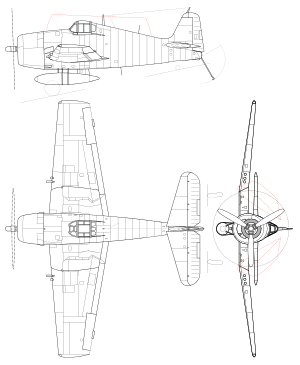
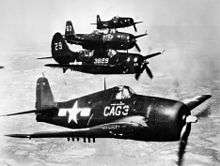
Data from WWII Aircraft Performance[93]Jane’s Fighting Aircraft of World War II[94]Standard Aircraft Characteristics[95]
General characteristics
- Crew: 1
- Length: 33 ft 7 in (10.24 m)
- Wingspan: 42 ft 10 in (13.06 m)
- Height: 13 ft 1 in (3.99 m)
- Wing area: 334 sq ft (31.0 m2)
- Aspect ratio: 5.5
- Airfoil: root: NACA 23015.6; tip: NACA 23009[96]
- Empty weight: 9,238 lb (4,190 kg)
- Gross weight: 12,598 lb (5,714 kg)
- Max takeoff weight: 15,415 lb (6,992 kg)
- Fuel capacity: 250 US gal (208 imp gal; 946 l) internal; up to 3 × 150 US gal (125 imp gal; 568 l) external drop tanks
- Zero-lift drag coefficient: 0.0211
- Drag area: 7.05 sq ft (0.655 m2)
- Powerplant: 1 × Pratt & Whitney R-2800-10W Double Wasp 18-cylinder air-cooled radial piston engine, 2,200 hp (1,600 kW) with a two-speed two-stage supercharger and water injection
- Propellers: 3-bladed Hamilton Standard, 13 ft 1 in (3.99 m) diameter constant-speed propeller
Performance
- Maximum speed: 391 mph (629 km/h, 340 kn)
- Stall speed: 84 mph (135 km/h, 73 kn)
- Combat range: 945 mi (1,521 km, 821 nmi)
- Ferry range: 1,530 mi (2,460 km, 1,330 nmi)
- Service ceiling: 37,300 ft (11,400 m)
- Rate of climb: 2,600 ft/min (13 m/s)
- Time to altitude: 20,000 ft (6,096 m) in 7 minutes 42 seconds
- Lift-to-drag: 12.2
- Wing loading: 37.7 lb/sq ft (184 kg/m2)
- Take-off run: 799 ft (244 m)
Armament
- Guns:
- 6× 0.50 in (12.7 mm) M2 Browning machine guns, with 400 rounds per gun, (All F6F-3, and most F6F-5) or
- 2 × 0.79 in (20 mm) AN/M2 cannon, with 225 rounds per gun and 4 × 0.50 in (12.7 mm) Browning machine guns with 400 rounds per gun
- Rockets:
- 6 × 5 in (127 mm) HVARs or
- 2 × 11 3⁄4 in (298 mm) Tiny Tim unguided rockets
- Bombs: up to 4,000 lb (1,800 kg) full load, including:
- Bombs or Torpedoes: (Fuselage mounted on centerline rack)
- 1 × 2,000 lb (910 kg) bomb or
- 1 × Mk.13-3 torpedo;
- Underwing bombs: (F6F-5 had two additional weapons racks either side of fuselage on wing center-section)
- 2 × 1,000 lb (450 kg) or
- 4 × 500 lb (230 kg)
- 8 × 250 lb (110 kg)
- Bombs or Torpedoes: (Fuselage mounted on centerline rack)
See also
- Alexander Vraciu, who had 19 victories on Hellcats flying with VF-6 (9) and VF-16 (10) during World War II.
- Robert Duncan, U. S. Navy Ace of World War II who scored the first victory against a Japanese Zero by a F6F Hellcat.
- David McCampbell, the top U.S. Navy ace of World War II with all of his 34 victories in the Hellcat, commander of Air Group 15 during World War II and recipient of the Medal of Honor.
- Eugene A. Valencia, Jr., top scoring ace of VF-9 during World War II with 23 victories while flying Hellcats.
- Battle of Palmdale
Related development
Aircraft of comparable role, configuration and era
- Focke-Wulf Fw 190
- Kawanishi N1K
- Kawasaki Ki-100
- Lavochkin La-5
- Mitsubishi J2M
- Mitsubishi A7M
- Nakajima Ki-84
- North American P-51 Mustang
- Republic P-47 Thunderbolt
- Vought F4U Corsair
Related lists
References
Notes
- The insignia red outline around the national markings indicate that this picture was taken circa June–September 1943.
- This can be broken down as 5,163 in the Pacific and eight more during the invasion of Southern France, plus 52 with the FAA during World War II.[8]
- On the previous day, while receiving the Medal of Honor from President Franklin D. Roosevelt, O'Hare was asked by the President what was needed in a new naval fighter; O'Hare's response was "something that would go upstairs faster."[16]
- Jackson emphasized to Grumman, "you can't hit 'em if you can't see 'em"[17]
- Late-production F6F-3s were powered by the same water-injected R-2800 used by the F6F-5.
- Quote: "... flown by 305 aces, most of any U.S. fighter in World War II."[45]
- meaning Fighter Mark I, Fighter Mark II and Night Fighter Mark II respectively
Citations
- "U.S. Naval Aircraft Marking." U.S. Naval Historical Center. Retrieved 11 March 2008.
- "Uruguayan Navy." Archived 11 June 2011 at the Wayback Machine aeroflight. Retrieved: 27 May 2012.
- Ferguson 2005, pp. 149–175.
- Thruelsen 1976, p. 135.
- Sullivan 1979, p. 4.
- Kinzey 1996, p. 4.
- Tillman 1996, p. 81.
- Tillman 1996, pp. 78–79.
- Murray, Williamson (2002). War In The Air 1914–45 (2002 Paperback ed.). Wellington House, London: Cassell. p. 202. ISBN 0-304-36210-7.
- Kinzey 1996, p. 16.
- Taylor 1969, p. 503.
- Kinzey 1987, p. 14.
- Thruelsen 1976, p. 166.
- Ewing 2004, p. 182.
- Ewing 2004, p. 86.
- Ewing and Lundstrom 2004, pp. 155–156.
- Tillman 1979, p. 6.
- Francillon 1989, p. 200.
- Kinzey 1996, p. 6.
- Ewing and Lundstrom 2004, pp. 155, 156.
- Kinzey 1987, p. 6.
- Sullivan 1979, pp. 24, 30, 33.
- Parsch, Andreas. "5 inch FFAR/HVAR." designation-systems.net, 2010. Retrieved: 28 October 2012.
- Kinzey 1996, pp. 30–31.
- Kinzey 1996, pp. 28–29.
- Green 1975, p. 91.
- Kinzey 1996, pp. 6–7.
- Kinzey 1996, p. 7.
- Green 1975, pp. 93–94.
- Kinzey 1987, p. 27.
- Kinzey 1996, p. 32.
- White 2001, pp. 260, 508.
- Kinzey 1996, pp. 17–18.
- Kinzey 1996, pp. 50–51.
- Sullivan 1979, p. 46.
- Winchester 2004, p. 110.
- Styling 1995, p. 67.
- Tillman 1996, p. 6.
- Dean 1997, p. 559.
- Spick 1983, p. 118.
- Tillman 1979, p. 9.
- "Fact Sheets: Kawanishi N1K2-Ja Shiden Kai." National Museum of the US Air Force. Retrieved: 23 November 2015.
- Barber 1946, Table 2.
- Barber 1946, Table 28.
- "Airpower Classics." Air Force Magazine, April 2006, p. 98.
- Kinzey 1987, p. 58.
- OPNAV-P-23V No. A129, 17 June 1946, p. 15.
- Dorr, Robert F. (21 October 2019). "Sharp Shooting Hellcat "Mac" McWhorter Runs Up the Score" (PDF). Flight Journal. Retrieved 22 July 2020.
- Green 1975, p. 93.
- Thruelsen 1976, p. 181.
- Tillman 1996, p. 96.
- Tillman 1996, p. 78.
- O'Leary 1980, pp. 147–148.
- http://www.historynet.com/goldilocks-fighter-f6f-hellcat.htm
- Jackson 1998, p. 126.
- http://img.wp.scn.ru/camms/ar/576/pics/21_1.jpg
- Donald, 1995, p. 145.
- "Historical aircraft of the Blue Angels." Archived 19 April 2012 at the Wayback Machine Blue Angels. Retrieved" 31 March 2015.
- Norton 2008, p. 38.
- Krist 2006, pp. 91–92.
- "Grumman F6F Hellcat/Bu. 79779." Fleet Air Arm Museum. Retrieved: 11 April 2012.
- "FAA Registry: N41476" Federal Aviation Administration. Retrieved: 21 July 2014.
- "Grumman F6F Hellcat/Bu. 41476." Collings Foundation. Retrieved: 26 March 2020.
- "FAA Registry: N30FG" Federal Aviation Administration Retrieved: 16 May 2011.
- "FAA Registry: N1078Z" Federal Aviation Administration. Retrieved: 16 May 2011.
- "Grumman F6F Hellcat/Bu. 70222." CAF Southern California Wing. Retrieved 22 January 2018.
- "FAA Registry: N79863" Federal Aviation Administration Retrieved: 16 May 2011.
- "Grumman F6F Hellcat/Bu. 79863." Flying Heritage Collection. Retrieved: 22 January 2018.
- "FAA Registry: N4998V" Federal Aviation Administration Retrieved: 16 May 2011.
- "Grumman F6F Hellcat/Bu. 94204." Erickson Aircraft Collection. Retrieved: 11 April 2019.
- "FAA Registry: N4964W" Federal Aviation Administration Retrieved: 2 June 2011.
- "Grumman F6F Hellcat/Bu. 94473." Palm Springs Air Museum. Retrieved: 23 February 2014.
- "Grumman F6F Hellcat/Bu. 25910." National Naval Aviation Museum. Retrieved: 24 April 2020.
- "Grumman F6F Hellcat/Bu. 41834." National Air & Space Museum. Retrieved: 13 December 2010.
- "Grumman F6F Hellcat/Bu. 42874." San Diego Aerospace Museum. Retrieved: 11 April 2012.
- "Grumman F6F Hellcat/Bu. 66237." NAS Wildwood Aviation Museum. Retrieved: 24 April 2020.
- "Grumman F6F Hellcat/Bu. 77722." aerialvisuals.ca. Retrieved: 25 February 2015.
- "Grumman F6F Hellcat/Bu. 79192." New England Air Museum. Retrieved: 11 April 2012.
- "Grumman F6F Hellcat/Bu. 79593." Patriots Point Museum. Retrieved: 11 April 2012.
- "Grumman F6F Hellcat/Bu. 79683." AirZoo. Retrieved: 13 January 2020.
- "Grumman F6F Hellcat/Bu. 94203." National Naval Aviation Museum. Retrieved: 24 April 2020.
- "Grumman F6F Hellcat/Bu. 94263." Cradle of Aviation Museum. Retrieved: 22 January 2018.
- "FAA Registry: N7537U." Federal Aviation Administration. Retrieved: 16 May 2011.
- "Grumman F6F Hellcat/Bu. 70185." Aerial Visuals. Retrieved: 13 December 2020.
- "FAA Registry: N9265A" Federal Aviation Administration Retrieved: 16 May 2011.
- "Grumman F6F Hellcat/Bu. 78645." aerialvisuals.ca Retrieved: 20 April 2020.
- "FAA Registry: N467RL." Federal Aviation Administration. Retrieved: 10 January 2018.
- "Grumman F6F Hellcat/Bu. 80141." Aerial Visuals. Retrieved: 10 January 2018.
- "Grumman F6F Hellcat/Bu. 93879." Yanks Air Museum. Retrieved: 12 May 2017.
- "FAA Registry: N4994V" Federal Aviation Administration. Retrieved: 12 May 2017.
- "FAA Registry: N7861C" Federal Aviation Administration Retrieved: 26 August 2014.
- "F6F Performance". wwiiaircraftperformance.org. WWII Aircraft Performance. Retrieved 23 November 2015.
- Bridgman 1946, pp. 233–234.
- Standard Aircraft Characteristics: F6F-5 Hellcat. NAVAER 1335A.
- Lednicer, David. "The Incomplete Guide to Airfoil Usage". m-selig.ae.illinois.edu. Retrieved 16 April 2019.
Bibliography
- Anderton, David A. Hellcat. London: Jane's Publishing Company Ltd., 1981. ISBN 0-7106-0036-4.
- Barber, S.B. Naval Aviation Combat Statistics: World War II, OPNAV-P-23V No. A129. Washington, D.C.: Air Branch, Office of Naval Intelligence, 1946.
- Bridgman, Leonard, ed. "The Grumman Hellcat." Jane’s Fighting Aircraft of World War II. London: Studio, 1946. ISBN 1-85170-493-0.
- Brown, Eric, CBE, DCS, AFC, RN., William Green and Gordon Swanborough. "Grumman Hellcat". Wings of the Navy, Flying Allied Carrier Aircraft of World War Two. London: Jane's Publishing Company, 1980, pp. 167–176. ISBN 0-7106-0002-X.
- Dann, Lcdr. Richard S., USNR. F6F Hellcat Walk Around. Carrollton, Texas: Squadron/Signal Publications Inc., 1996. ISBN 0-89747-362-0.
- Dean, Francis H. America's Hundred Thousand. Atglen, Pennsylvania: Schiffer Publishing Ltd., 1997. ISBN 0-7643-0072-5.
- Donald, David, ed. American Warplanes of World War II. London: Aerospace Publishing, 1995. ISBN 1-874023-72-7.
- Drendel, Lou. "Grumman F6F Hellcat". U.S. Navy Carrier Fighters of World War II. Carrollton, Texas: Squadron/Signal Publications Inc., 1987, pp. 45–68. ISBN 0-89747-194-6.
- Ewing, Steve. Reaper Leader: The Life of Jimmy Flatley. Annapolis, Maryland: Naval Institute Press, 2002. ISBN 1-55750-205-6.
- Ewing, Steve. Thach Weave: The Life of Jimmie Thach. Annapolis, Maryland: Naval Institute Press, 2004.ISBN 1-59114-248-2.
- Ewing, Steve and John B. Lundstrom. Fateful Rendezvous: The Life of Butch O'Hare. Annapolis, Maryland: Bluejacket Books, (Naval Institute Press), 2004. ISBN 1-59114-249-0.
- Faltum, Andrew. The Essex Aircraft Carriers. Baltimore, Maryland: The Nautical & Aviation Publishing Company of America, 1996. ISBN 1-877853-26-7.
- Ferguson, Robert G. "One Thousand Planes a Day: Ford, Grumman, General Motors and the Arsenal of Democracy."History and Technology, Volume 21, Issue 2, 2005.
- Francillon, Réne J. Grumman Aircraft Since 1929. Annapolis, Maryland: Naval Institute Press, 1989. ISBN 0-87021-246-X.
- Graff, Cory. F6F Hellcat at War (The At War Series). Minneapolis, Minneapolis: Zenith Press, 2009. ISBN 978-0-7603-3306-8.
- Green, William. Famous Fighters of the Second World War. Garden City, New York: Doubleday & Company, 1975.ISBN 0-385-12395-7.
- Green, William and Gordon Swanborough. "Grumman F6F Hellcat". WW2 Fact Files: US Navy and Marine Corps Fighters. London: Macdonald and Jane's Publishers Ltd., 1976, pp. 47–56. ISBN 0-356-08222-9.
- Gunston, Bill. Grumman: Sixty Years of Excellence. London: Orion Books, 1988. ISBN 1-55750-991-3.
- Hill, Richard M. Grumman F6F-3/5 Hellcat in USN-USMC-FAA-Aeronavale & Uruguayan Service. Reading, Berkshire, UK: Osprey Publications Ltd., 1971. ISBN 0-85045-023-3.
- Jackson, Robert. Air War Korea 1950–1953. Shrewsbury, UK: Airlife Publishing, 1998. ISBN 1-85310-880-4.
- Jarski, Adam and Waldemar Pajdosz. F6F Hellcat (Monografie Lotnicze 15) (in Polish). Gdańsk, Poland: AJ-Press, 1994. ISBN 83-86208-05-8.
- Jarski, Adam and Waldemar Pajdosz. F6F Hellcat (Aircraft Monograph 20). Gdańsk, Poland: AJ-Press, 2007.
- Kinzey, Bert. F6F Hellcat in detail and scale (D&S Vol.26). Shrewsbury, UK: AirLife Publishing Ltd., 1987.ISBN 1-85310-603-8.
- Kinzey, Bert. F6F Hellcat in detail and scale: Revised edition (D&S Vol.49). Carrollton, Texas: Squadron/Signal Publications Inc., 1996. ISBN 1-888974-00-1.
- Kit, Mister and Jean-Pierre DeCock. F6F Hellcat (in French). Paris, France: Éditions Atlas s.a., 1981.
- Krist, Jan. Bojové Legendy: Grumman F6F Hellcat (in Czech). Prague, Czech Republic: Jan Vašut s.r.o., 2006. ISBN 80-7236-432-4.
- Mendenhall, Charles A. Wildcats & Hellcats: Gallant Grummans in World War II. St. Paul, Minnesota: Motorbooks International, 1984. ISBN 0-87938-177-9.
- Mondey, David. American Aircraft of World War II (Hamlyn Concise Guide). London: Bounty Books, 2006. ISBN 978-0-7537-1461-4.
- Norton, Bill. U.S. Experimental & Prototype Aircraft Projects: Fighters 1939–1945. North Branch, Minnesota: Specialty Press, 2008, pp. 80–85. ISBN 978-1-58007-109-3.
- O'Leary, Michael. United States Naval Fighters of World War II in Action. Poole, Dorset, UK: Blandford Press, 1980. ISBN 0-7137-0956-1.
- "OPNAV-P23V No. A129, 17 June 1946." Naval Aviation Combat Statistics World War II. Suitland, Maryland: Air Branch, Office of Naval Intelligence, Office of the Chief of Naval Operations, 1946.
- Spick, Mike. Fighter Pilot Tactics . The Techniques of Daylight Air Combat. Cambridge, UK: Patrick Stephens, 1983. ISBN 0-85059-617-3.
- Styling, Mark. Corsair Aces of World War 2 (Osprey Aircraft of the Aces No 8). London: Osprey Publishing, 1995. ISBN 1-85532-530-6.
- Sullivan, Jim. F6F Hellcat in action. Carrollton, Texas: Squadron/Signal Publications Inc., 1979. ISBN 0-89747-088-5.
- Taylor, John W. R. "Grumman F6F Hellcat." Combat Aircraft of the World from 1909 to the present. New York: G.P. Putnam's Sons, 1969. ISBN 0-425-03633-2.
- Thetford, Owen. British Naval Aircraft Since 1912, Fourth Edition. London: Putnam, 1994. ISBN 0-85177-861-5.
- Thomas, Geoff. US Navy Carrier Aircraft Colours: Units, Colours, Markings, and Operations during World War 2. New Malden, UK: Air Research Publications, 1989. ISBN 1-871187-03-6.
- Thruelsen, Richard. The Grumman Story. Westport, Connecticut: Praeger Publishers, 1976. ISBN 0-275-54260-2.
- Tillman, Barrett. Hellcat Aces of World War 2. London: Osprey Aerospace, 1996. ISBN 1-85532-596-9.
- Tillman, Barrett. Hellcat: The F6F in World War II. Annapolis, Maryland: Naval Institute Press, 1979. ISBN 0-87021-265-6.
- White, Graham. R-2800: Pratt & Whitney's Dependable Masterpiece. Warrendale, Pennsylvania: Society of Automotive Engineers Inc., 2001. ISBN 978-0-76800-272-0.
- Winchester, Jim, ed. "Grumman F6F Hellcat." Aircraft of World War II (Aviation Fact File). Rochester, UK: Grange Books plc, 2004. ISBN 1-84013-639-1.
- Zbiegniewski, Andre R. Grumman F6F Hellcat (Kagero Monografie No.10) (Bilingual Polish/English). Lublin, Poland: Kagero, 2004. ISBN 83-89088-49-5.
External links
| Wikimedia Commons has media related to Grumman F6F Hellcat. |
- "Meet the Hellcat (1943)" on YouTube
- Final flight test report of F6F-3, USN Air Station, Patuxent River (pdf file)
- F6F Hellcat Performance Trials, Aircraft and Armament Experimental Establishment (A&AEE), Boscombe Down
- Performance test, each 1,00th aircraft; F6F-5 No 58310, USN Air Station, Patuxent River (pdf file)
- USN & USMC Aircraft Serial and Bureau Nos. 1911 to present
- "How The Hellcat Got That Way", Popular Science, December 1943, World War Two article which is large and detailed